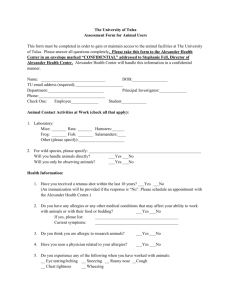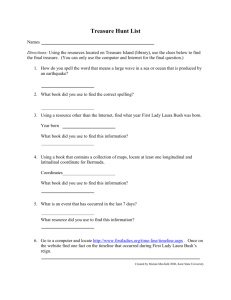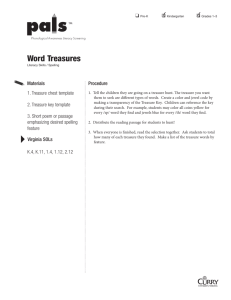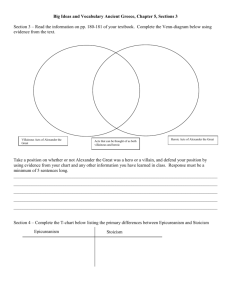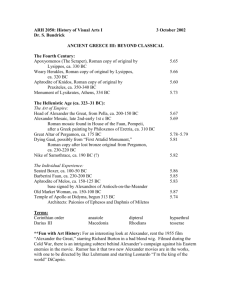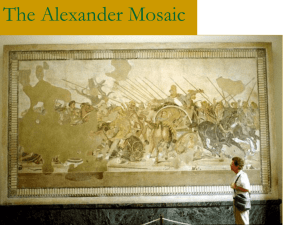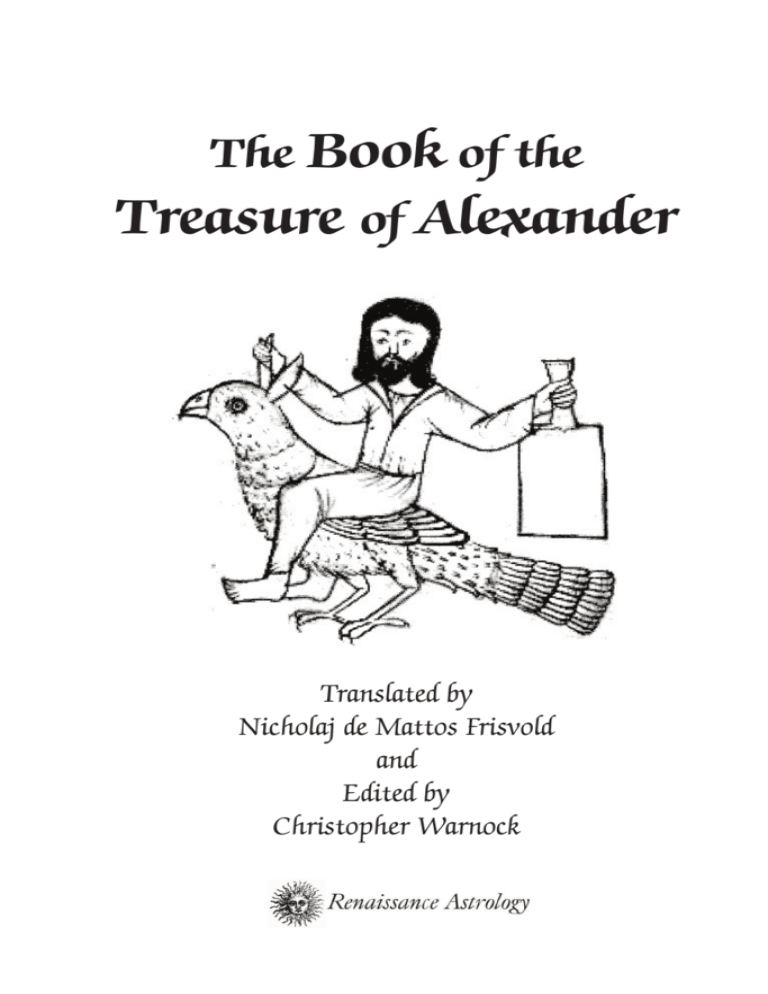
The Book of the
Treasure of Alexander
Translated by
Nicholaj de Mattos Frisvold
and
Edited by
Christopher Warnock
Copyright © 2010 Nicholaj de Mattos Frisvold
and Christopher Warnock
All Rights Reserved
The Book of the Treasure of Alexander
Contents
Occult Virtue & Hermetic Philosophy
Alexander, Aristotle & Hermes Trismegistus
Notes on the Translation Warning and Disclaimer
And this is the index of the Arts of the book
1
4
5
6
13
The First Art
The Chapter of the Formation of Things
The Chapter about the Indications of the Two
Benefic Stars
The Chapter about the Greater Luminary
14
15
15
The Second Art of the Process of Elaboration and
Manipulation of the Three Elixirs
Section on the Extraction of the Active Water, called Sapius Extraction of the Second Water called Qurial
Extraction of the Third Water called Rarasius
Extraction of the Fourth Water that is extremely
useful and is called Triras
Chapter about the Extraction of the Essence deposited
in the strength of Mars
Chapter about the Purification of Arsenic
Another chapter about the Purification of Arsenic,
which is easier than the first
Chapter of the Sublimation of the Purified Arsenic Chapter of the Purification of Copper
23
23
23
24
25
26
26
27
27
The Book of the Treasure of Alexander
Chapter about how to make it whitish and make it look
like Silver being what was bequeathed by Hermes and
to what Balinas also dedicated himself
28
Chapter about other method of whitening of Copper
28
Chapter about how to soften purified Copper
29
Recipe of the great softener water to which Hermes
called Kalianus, that means, the one that takes
out dryness
30
Chapter about the transmutation of Copper to the
appearance and form of Gold
30
Description of the purification of Tutia
31
Purification of the Copper in which one wishes to
sublimate
32
Chapter about the purification of Silver by fire from
Tin in a foundry, this being so famous in all times
and nations that it need not be repeated here
32
Chapter about the elixir of Silver that transmutes
it into the color of Gold
There are four principles required for this Elixir:
the First will be the Foundation
The Second Principle
The Third Principle
The Fourth Principle
Description of how to use this Elixir upon Silver
33
34
34
34
35
The Book of the Treasure of Alexander
The Third Art of the Treasure of Alexander
regarding poisons
The first poison is Jibta
How to make the poison called Talius
How to make the poison called Bich bar bich
How to make the poison that is called Analimus
How to make the poison called Jaranias
How to make the poison prepared by Qinan ibn Anuch
Description of the poison called Ailailawus
Description of the poison know as Qiyathara, that
means ‘the Royal Liquid’
How to make the poison known as Abararis, which
means ‘the one that kills in two ways’
How to make the poison known as Athanasialus,
which means ‘the poison of one hour’ which is
made with gall bladders
How to make the poison called Sithalamas, which
means ‘the one that kills whoever touches it’
How to make the poison called Sitatus, that means
‘the one of vegetal origin’ which is prepared
from plants
How to make the poison that kills by bleeding diarrhea
Description of the poison that kills though laughter Description of the poison Anarus, which means
‘the cold poison’
The Influence of the Moon over Poisons
36
37
37
38
39
39
39
40
40
41
42
42
43
43
44
45
The Book of the Treasure of Alexander
The Fourth Art concerning the preparation of the
antidotes that cure poisoning
The preparation of the antidote known as al-Biãnûs,
which is called ‘the reason of life’ by Mihlâyil ibn
as-Sayyid Qinãn
46
The preparation of the antidote of Hermes, which saves
everyone from poisons
47
The preparation of the antidote which Hermes called
Athîr Sãliûs (the ether of Salius), which means
‘the fixation of life’
47
The creation of the antidote that Hermes prepared to
restrain the evil in poisons
48
The creation of the antidote called by Hermes, Aililûniûs,
which means, ‘that which penetrates with
great force’
48
The creation of the antidote Dardhâlûch, which means,
‘done by the vipers flesh’
49
The Fifth Art is the use of Talismanic Remedies
Talisman for curing all diseases of the mouth, like
diphtheria and similar afflictions
Talisman of Bilâuânûs, which signifies pains in the
sciatic nerve, which is an affliction of intense pain
Talisman against retention of urine
Talisman for calming down fury, having as one of its
effects the instant calming of the belly How to make the talisman against pains in the liver
50
51
51
52
52
The Book of the Treasure of Alexander
How to make the talisman against the pains in
the kidney
The account of Sâlâriûs, which means ‘the blessed’,
useful for whoever has a tendency to get
overly excited
A talisman for easing pain in the eyes
The talisman known as Anâliûsis, which means, ‘what
is useful against toothache’
53
54
54
55
The Sixth Art is the Seals of the Seven Planets
Description of the seal of the Sun, where you will
find Hermes
How to make the seal of the Moon to calm down
turmoil, intrigues, confrontations, and to calm
down agitations and excess.
How to make the seal of Saturn that calms down the
desire for union, and agitations of the blood, the
flow of fevers in the blood, to lower the heat of the
liver and against pest
This is also the talisman of the scorpion , that will cause
them flee from whomever is using it
How to make the seal of Mars, which makes cowards
brave, strengthens your heart and guards it against
deceivers, thieves and enemies How to make the seal of Jupiter which diminishes
weakness and beating of the heart at the time of its
use, and ends physical discomfort and colic of
the stomach How to make the seal of Mercury, which dispels
hemiplegia, facial paralysis, smallpox, convulsions
and all cold afflictions 56
57
58
58
59
59
60
The Book of the Treasure of Alexander
The Seventh Art is called the Talismanic Art
How to make the seal of Venus, which generates sympathy
and attraction towards women and increase
sexual potency 61
Talisman for stopping hemorrhage, dysentery and
bleeding from any part of the body 62
Talisman to remove scorpions from a city 63
How to make the seal that cures the sting of scorpions,
with the permission of God Almighty 64
How to make the talisman of the snakes 64
How to make the talisman that drives away locusts 65
How to make the talisman that Hermes prepared in order
to calm strong winds 66
How to make the seal that stops tertian and
quartian fever 67
How to make the talismanic seal that stops, for he who
uses it, phlegmatic fever that recurs every day 67
How to make the seal that stops tertian fever of the
yellow bile 68
How to make the talisman against strong fever
(ad-daqiqah) that attacks the vital organs
68
Talisman for the destruction of nations and to cause
intrigues 69
Talisman for making the hearts of women or beardless
youths uniquely well disposed towards whomever
wears it, and cause beauty and brilliance to shine
from the eyes, in such way that people will be inclined
towards obedience, protection and desire the company
of its wearer 70
The Book of the Treasure of Alexander
The talisman known as Kiklâiûs, which means
‘the useful food’ 71
The Eighth Art is of Incenses and the forms of
sympathy and antipathy
The First Chapter concerning the science for winning
hearts and making souls friendly
The Second Chapter concerning the calming of fury of
kings and obtain the necessary submission
from someone
The Third Chapter concerning the emanation of souls
and the antipathy between them
72
74
76
The Ninth Art explains the powers created
through growing melons, known as Bâstitalitus
anânûs, which means ‘the manipulation of what is
receptive to spiritual effects and what transforms
nature’
The preparation of the melon called ‘Asiâlâiûs,
which means ‘confused mind’
Preparing the melon, called Kalkiâiûs, which means
‘the increase of intellect and understanding’
Preparing the melon called Kititâthâ, which means
‘the strong laxative of the yellow bile’
78
78
79
The Book of the Treasure of Alexander
The Tenth Art, where Hermes speaks about the
properties of animals
Chapter about sympathy and antipathy
Chapter on how to obtain prestige
Chapter on how to obtain prestige and esteem
Here is how to prepare what is a fatal poison
How to make the antidote for this poison
About the treatment of the insane
Treatment for leprosy
A talisman for horses
Chapter on the virtues Hermes indicated that are
found in the swallow
Chapter on the power for love that is found in owls
and pigs
Treatment for insanity using owls
Chapter about enmity
To strengthen desire
For the wounds of quadrupeds and for chronic ulcers
in humans
Chapter on enmity Peculiarities of the black dog
Peculiarities of the black cat
The end of the book
80
81
81
82
82
82
83
83
83
84
84
84
84
85
85
85
85
The Book of the Treasure of Alexander
Appendix A
Measurements
88
Appendix B
Planetary Rings from the Book of the Treasure
of Alexander
The Ring of Saturn
The Ring of Jupiter
The Ring of Mars
The Ring of The Sun
The Ring of Venus
The Ring of Mercury
The Ring of The Moon
89
90
91
92
93
94
95
96
Bibliography
Bibliography
97
Occult Virtue & Hermetic Philosophy
D
iscussing astrological magic in his Speculum Astronomiae,
the “Mirror of Astronomy”, the thirteenth century scholar,
philosopher and scientist Albertus Magnus recoils from what
he describes as the abominable use of necromantic images, “which
have presumed to usurp the noble name of [astrology] for themselves.”
“But the worst of these”, says Albertus, “is that written by Aristotle to
Alexander…this is the one which some call Mors animae (The death of
the soul).”1
The Book of the Treasure of Alexander, here in its first complete
English translation, certainly merits Albertus’ description even if, as
many manuscripts attributed to Aristotle and Alexander circulated
in the Middle Ages and Renaissance, this is not the specific version
Albertus consulted. Much of the Book of the Treasure of Alexander is
taken up with descriptions of deadly poisons, often composed of rather
noisome substances. Even the antidotes require brains, blood and
other body parts, both animal and human.
But unlike a modern horror film, these ingredients are not meant
1 Albertus Magnus, Speculum Astronomiae, trans. Burnett & Lippincott, (Kluwer,
1992) page 243.
2
The Book of the Treasure of Alexander
to shock and titillate, but to allow the mage to utilize the occult virtues
or hidden powers scattered throughout material things. Explicitly
referring to Hermes Trismegistus, the Book of the Treasure of Alexander
is reliant on Hermetic and Neoplatonic philosophy which holds that all
things exist perfectly and undifferentiated in the One, then manifested
perfectly, but differentiated as archetypes, Platonic Ideas and
Archangels, thoughts in the Divine Mind, the Anima Mundi. Next
all things manifest in the intermediate Celestial or Imaginal world,
where the Platonic Ideas take on form and form exists without space
or weight. Finally, all things manifest in the Material World, while
retaining their spiritual connection to the intermediate worlds and
Platonic Ideas that gave rise to them and ultimately to the One itself.
Hidden in the natural world and particular in Man himself, a
perfect Microcosm or little world, encapsulating the Macrocosm or
Greater World of the Cosmos, were spiritual powers and potencies.
The wise man could find the power to kill or to save from death
concealed in vipers’ heads, in donkey’s urine or even wild onions.
But a nobler use of these hidden powers was alchemy, one of the
three Hermetic arts with astrology and magic. Here the virtue of
the quintessence, the fifth element, was sought in nature, purified,
repeatedly transmuted and transformed, until the lapis philosophorum,
the Philosopher’s Stone was revealed to the adept. The Book of the
Treasure of Alexander adds several fascinating new chapters to our
knowledge of authentic Hermetic alchemy, explaining the successive
preparations of various “waters” and the purification of metals. Each of
these waters and purified metals has its uses, but contributes to the next
step in a unified process. Finally, the Book of the Treasure of Alexander
explains four principles used to create, “the All, a red Stone that tends
a little to black. This is the Great Elixir.” Among the potencies of this
elixir is the power to change silver into pure gold.
After scaling the heights of the creation of the Philosopher’s Stone,
the Book of the Treasure of Alexander then descends to descriptions of
over a dozen deadly poisons, including the “Royal Water”, the “cold
poison” and the “poison that kills through laughter” many of which
have their powers enhanced through their creation according to
astrological timing. The effects of these poisons are all explicable as the
combination of astrology and their respective natural occult virtues.
The Book of the Treasure of Alexander
3
Soundly Hermetic in theory while despicable in actual use, the Book
of the Treasure of Alexander does not shrink from carefully describing
the preparation of these virulently lethal compounds. Yet the Hermetic
balance of nature is restored by the fourth section, a recognition that
for every poison, as every evil, a stronger and more potent antidote
exists.
The Book of the Treasure of Alexander then shifts its focus to
astrological talismans. Thirty hitherto unknown talismans are set forth,
most provided with special images from the original Arabic manuscript,
giving us a wealth of new astrological talismans to work with. The
Book of the Treasure of Alexander even provides a new set of planetary
invocations for Venus, Mars and Mercury accompanying its section on
creating astrological statuettes.
One of the most fascinating uses of occult virtues is the “melon
magic” Eighth Art of the Book of the Treasure of Alexander which
appears in an abbreviated form in Book IV, chapter 7 of Picatrix, the
most famous of astrological grimoires. The Book of the Treasure of
Alexander explains that melons most easily blend or transform whatever
they are mixed with. Melons planted in the skull of a donkey cause the
eater to lose intelligence, while those planted in the skull of a human,
increase knowledge and wisdom!
What might, at first glance, appear to be a miscellaneous collection
of chapters on astrology, poisons, antidotes, alchemy and astrological
magic, in fact, share the common thread of the practical application
of Hermetic philosophy through occult virtue. For the scholar of
Hermeticism and the practicing Hermetic adept, this truly is a treasure.
67 8
4
The Book of the Treasure of Alexander
Alexander, Aristotle & Hermes Trismegistus
A
lexander the Great, the 4th century BC king of Macedon,
attained legendary status even during life and his stature only
increased after his death. Building on his father Philip’s control
of Greece, he conquered the mighty Persian empire and extended his
rule over Egypt, Asia Minor and even into India. The Greek Alexander
Romance and later Islamic Iskander Namah detail the legendary exploits
of Alexander, including explorations of the sky carried by eagles or
griffons and diving beneath the sea in a crystal or wooden vessel. In
the advanced Islamic civilization of the Middle Ages Alexander was
equated with the Quranic Dhul-Qarnayn, the “Two Horned One”, a
great ruler who reached the rising place of the Sun and erected a great
iron wall against the giants Gog and Magog. That Alexander had
been tutored and advised by the great philosopher Aristotle excited
considerable interest in the Middle Ages, particularly as esoteric works
on astrology and magic were later attributed to Aristotle. Alexander’s
magical reputation was further enhanced by the Alexander Romance
which explained that he was the son of the Egyptian pharaoh and
renowned magician, Nectanebo.
The Book of the Treasure of Alexander is prefaced by an introduction
explaining its magical provenance. It was found, according to the
introduction, during the reign of the 9th century Abbasid Caliph
Al-Mutasim in the Byzantine city of Amuria, known in Arabic as
Amuriyat or Ammuriye. After the forces of the Caliph conquered the
city they investigated the contents of a monastery known as the House
of the Legacy. After considerable effort and a prophetic dream of the
Caliph himself, they discovered within the walls of the monastery a
vault of copper containing a smaller vault of gold, within which was a
book engraved in gold and written in Greek and Latin, the Book of the
Treasure of Alexander.
Despite the fascinating and exotic story of its origin, the Book of the
Treasure of Alexander is clearly in the mainstream of medieval Islamic
Hermeticism as can be seen from the frequent references to Hermes
Trismegistus and its reliance on Hermetic philosophy. Julius Ruska,
the famous German scholar of alchemy, discussed the Book of the
The Book of the Treasure of Alexander
5
Treasure of Alexander in his magisterial 1926 Tabula Smaragdina, the
“Emerald Tablet” of Hermes Trismegistus and it appears to stem from
the pagan Harranian Sabians who were the source of so much magical,
astrological and alchemical material, including Picatrix.2
Notes on the Translation
T
he English translation of the Book of the Treasure of Alexander
that appears here was made by Nicholaj de Mattos Frisvold
from the Livro do Tesauro de Alexandre, Um estudo de hermética
árabe na oficina da historia da ciencia (translated from the original
Arabic) by AM Alfonso-Goldfarb & SAC Jubran (Petropolis, Brazil,
1999). The Portuguese translation was in turn made from three Arabic
manuscripts, Department of Arabic Studies of the Public Library of
Berlin, cod. 4193 (Ahlwardt Cat./We II 1209) dating from 1688 AD;
British Library, cod. 473 (Loth Cat.) undated; Derenbourg Catalogue
947 of Escorial Library, Madrid, dated to 904 AD, but likely produced
in the fourteenth century.
The Book of the Treasure of Alexander has thus taken a rather
circuitous route in being translated into English. Rather than leaving
passages in a literal but unintelligible state I have used my knowledge
of traditional astrology and magic, gained from over a decade of study
and practice, to recast them in logical and coherent form.
vwu
2 Listening to the whispers of matter through Arabic hermeticism: new studies on The
Book of the Treasure of Alexander. Alfonso-Goldfarb AM, Jubran SA. Ambix. 2008
Jul;55(2):100.
6
The Book of the Treasure of Alexander
Warning and Disclaimer
T
he material in this book includes descriptions of processes and
activities that may be hazardous, illegal, or both. Readers
are urged to use their own discretion, to be aware of the
potential risks involved in such processes and activities, and to
consult with appropriate licensed professionals before making
any attempt to perform any such processes or activities. The
translator, editor and publisher of this book shall have no liability nor
responsibility with respect to any loss or damage caused or alleged to be
caused by reading or following any of the instructions in this book.
0 45

